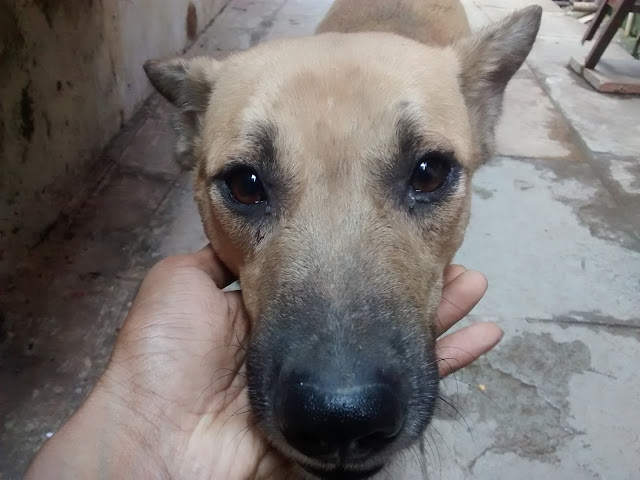A Chapter from a Dog's Life
Stray dogs are amazing beings. They are happy to live off the leftovers found in the garbage dumps or on scraps thrown at them. They find shelter under a parked truck in the day or curl up like a ball in a corner at night. Rain, sunshine, disease and hunger don't deter them. They aren't owned or cared for by anyone but they fiercely defend the territory that they live in. It is not hard to imagine how the idiom - it is a dog's life came into existence. Pet dogs lead a far comfortable life, irrespective of the breed.

He never turned up for the first few days after the injury. He went underground. Probably to heal the wounds himself. But eventually he emerged. He shied away from the betadine and shook off the turmeric each time I tried to apply it. He could be tempted to stand still with some parle-G biscuits but never did he hold on for too long. We persisted and hoped against hope that our remedy would work. For a few days, it went off well. We developed a schedule around the treatment. Late at night he would emerge from the darkness and packets of Parle-G, a bowl of milk and lots of turmeric would await him. He gave in eventually and we went off to sleep with some sense of satisfaction and hope.
But one night, we saw him whining in pain, running around aimlessly. When I approached him, he wagged his tail slowly. He would run and then sit to scratch his wound with his hind legs. He smelled of rotten flesh. When I finally got around to petting him, I flashed my torch on the wound, only to see what I had been dreading. The wound seem to be breathing, a trickle of blood ran from it, and along with the stench it became clear that he was infested with maggots.
One of the most common problems facing all wounded animals especially stray dogs and cattle is Myiasis. In urban areas, flies regularly hatch their eggs into wounds and the larvae that emerge wreak havoc by boring deep into the animal's flesh, eating away at skin and tissue. A small wound can turn into a gaping hole, irritating the animal and may even eventually kill it.
What followed is interesting and can be tried at home, with some adult supervision. If you notice an injured dog in your neighbourhood - either call up Karuna or follow the procedure mentioned below.

As much as I'd like, I have not had a pet dog except for this one short time when I was 13 (Suzie died within 6 months). To make up for it, I have always forged friendship with all the stray dogs I come across on a daily basis. Feeding them occasionally, playing with them and picking their ticks off their hide means time well spent. Sometimes we have even helped secure a corner for their new born puppies and cared for the minor injuries. But when Whitey, the big adult dog was injured in the shoulder and hind leg in a pre-mating fight with a rival dog, we thought it could be healed with the normal - betadine + turmeric remedy.
He never turned up for the first few days after the injury. He went underground. Probably to heal the wounds himself. But eventually he emerged. He shied away from the betadine and shook off the turmeric each time I tried to apply it. He could be tempted to stand still with some parle-G biscuits but never did he hold on for too long. We persisted and hoped against hope that our remedy would work. For a few days, it went off well. We developed a schedule around the treatment. Late at night he would emerge from the darkness and packets of Parle-G, a bowl of milk and lots of turmeric would await him. He gave in eventually and we went off to sleep with some sense of satisfaction and hope.
But one night, we saw him whining in pain, running around aimlessly. When I approached him, he wagged his tail slowly. He would run and then sit to scratch his wound with his hind legs. He smelled of rotten flesh. When I finally got around to petting him, I flashed my torch on the wound, only to see what I had been dreading. The wound seem to be breathing, a trickle of blood ran from it, and along with the stench it became clear that he was infested with maggots.
One of the most common problems facing all wounded animals especially stray dogs and cattle is Myiasis. In urban areas, flies regularly hatch their eggs into wounds and the larvae that emerge wreak havoc by boring deep into the animal's flesh, eating away at skin and tissue. A small wound can turn into a gaping hole, irritating the animal and may even eventually kill it.
What followed is interesting and can be tried at home, with some adult supervision. If you notice an injured dog in your neighbourhood - either call up Karuna or follow the procedure mentioned below.
------
We had to act quickly. His pain was unbearable to him and us. I knew chloroform could help but there was no way of obtaining it. Chemists shook their heads rapidly each time I enquired. In sheer desperation, I googled remedies and came across two very helpful posts. Jaagruti and Welfare of Stray Dogs had posted a detailed procedure of treating maggot infested wounds. I needed a couple of things which I bought from a medical shop that stocks Veterinary medicines.
1. Topicure Spray (D-Mag or Himalaya's Scavon; available on Amazon) - Rs. 75/Rs. 220 (250 ml)
2. Neosporin powder (Neomycin) - Rs. 60
3. Betadine Solution - Rs. 80
4. Lorexane Cream (or Acrilin) - Rs. 45
5. Himax Cream - Rs 45
6. Negasunt Powder - Rs. 60 ( can be used if Topicure isn't available)
The procedure is simple if the dog is co-operative which Whitey was, but only partially. I often had to cajole him and talk to him during the entire process. Or sometimes restrain him with one hand. Make sure you are friendly with the dog before attempting this because an injured dog may bite out of irritation. Trust is vital. Use thick rubber gloves as a safety precaution if you are unsure.
The procedure prescribed involved using Medical turpentine oil or chloroform to kill the maggots. Neither was available so I skipped this step and relied on Topicure spray. The stinging sensation caused by the impact and of the eucalyptus contents of it caused Whitey to run. Make sure this treatment is performed in an open space with no kids running around. Next step was to clean the maggots which had started to emerge after the first few applications, in the same evening. One had to use tweezers to pluck them off but again Whitey was resistant to it and instead he tried to lick them off, while I flicked some that I could with my fingers.
Next, I filled a syringe with betadine and flushed the wound with it. Neosporin came next which helped to dry the wound. The following two steps were the most important. I took some Lorexane (you can also use Acrilin) on my hand and applied it over the wound (I was wearing basic disposable gloves). This helps tissue healing and fights maggots. Lastly I applied a liberal amount of Himax which essentially prevents flies from coming near the wound. This ensures that repeat infection doesn't occur. We also applied some turmeric powder each time. Remember, the effect of Himax wears out in about 12 hours so dressing must be done twice a day.
The next day, I was relieved to find no signs of maggots. We continued the same line of treatment, ensuring that Topicure was spread all over the wound and Himax was liberally applied every 12 hours. I stopped using a glove but instead used an old plastic spatula to apply the lotions properly.
Over the next few weeks, we monitored him closely and even tried to feed him Amoxicillin 250 crushed and mixed in his milk, which he refused to drink. In the weeks that followed, the biggest challenge remained was that of convincing the community that an injured dog was not a mad dog. He could be spotted running around aimlessly because he feared humans would hurt him. Everyone had been treating him like a pest. But with the treatment showing some results, most of the folks changed their stand. Some even offered to spray Topicure in my absence (or presence because Whitey would run away each time he saw the can in my hand)
With a good diet, adequate rest, regular dressing - Whitey managed to heal himself. It was not a difficult process but it needed persistence. The life of a dog may not have value for a lot of folks, but those utilitarian thinkers might know an injured dog could easily be a threat to the society and at least for that, it must be healed.
The idea behind this post is to encourage community participation in the welfare of dogs. A small wound if treated promptly with Betadine, Neosporin and Himax will heal quickly without getting infested with maggots. And who knows, in the process you might even gain a friend for life!
Over the next few weeks, we monitored him closely and even tried to feed him Amoxicillin 250 crushed and mixed in his milk, which he refused to drink. In the weeks that followed, the biggest challenge remained was that of convincing the community that an injured dog was not a mad dog. He could be spotted running around aimlessly because he feared humans would hurt him. Everyone had been treating him like a pest. But with the treatment showing some results, most of the folks changed their stand. Some even offered to spray Topicure in my absence (or presence because Whitey would run away each time he saw the can in my hand)
With a good diet, adequate rest, regular dressing - Whitey managed to heal himself. It was not a difficult process but it needed persistence. The life of a dog may not have value for a lot of folks, but those utilitarian thinkers might know an injured dog could easily be a threat to the society and at least for that, it must be healed.
The idea behind this post is to encourage community participation in the welfare of dogs. A small wound if treated promptly with Betadine, Neosporin and Himax will heal quickly without getting infested with maggots. And who knows, in the process you might even gain a friend for life!






Comments